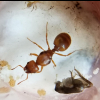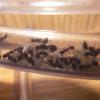I may be a noob when it comes to anting but I'm pretty sure this is some sort of Camponotus queen. I'm thinking Camponotus Pennsylvanicus.
I'm still a noob though so here is the info about it:
1. Location (on a map) of collection: Near Worcester MA
2. Date of collection: May 23rd
3. Habitat of collection: Under a rock in my yard(I've found both my queens with 3 meters of each other. I've found most ants there in a big pile of rocks)
4. Length (from head to gaster): 1cm to 1.2cm
5. Color, hue, pattern and texture: Shiny gastor with stripes
6. Distinguishing characteristics: It has wing scars
7. Distinguishing behavior: N/A
8. Nest description: N/A
9. Nuptial flight time and date: idk prob yesterday may 22nd but idk since it hasn't rained for a bit
Pictures:https://imgur.com/gallery/Fim8KGa
I put some stuff for her to sit on-top of in a bowl of water. You can also compare her size to the penny.
She is now in a test tube set up wrapped in foil and some cloth. This is gonna be my first legit non-parasitic queen! ![]()
It would be funny if this isn't a Campononotus sp. XD
I wanted a tetramorium queen but this'll do
Thanks you to all that reply!


















